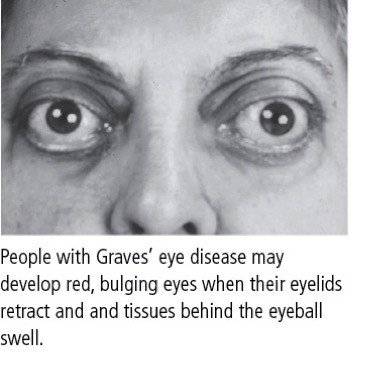Graves' eye disease
Medically reviewed by Drugs.com. Last updated on Aug 5, 2025.
What is Graves' eye disease?

Graves' eye disease, also called Graves' ophthalmopathy, is an eye condition that develops in people with an overactive thyroid caused by Graves' disease. Up to 25% of people with Graves' disease develop eye symptoms, and the condition is more common in women than in men. Usually the eye symptoms are mild and easily treated.
Eye problems result from the swelling of tissues, muscles, and fat in the socket behind the eye. This swelling causes exophthalmos, an abnormal protrusion of the eye. The eyelids and membranes may retract as they swell. This can lead to exposure and infection of the cornea. The cornea is the transparent, dome-shaped "window" that lies directly over the eye's pupil and iris.

In serious cases, the swelling can cause pressure on the muscles that move the eyeball so that the eye cannot move properly. Also, the swelling can put pressure on the optic nerve, impairing vision.
Symptoms of Graves' eye disease
Symptoms of Graves' eye disease include:
- Early symptoms: Feeling of irritation in the eyes, excessive tearing or dry eye, forward displacement of the eye, sensitivity to light and double vision
- Late symptoms: Swelling of the eye, inability to move the eye, corneal ulceration, and, rarely, loss of vision.
Graves' disease is usually associated with other symptoms of overactive thyroid,such as weight loss, a racing heart, or feeling warmer than usual. However, the classic symptoms of hyperthyroidism are not always present. In fact, Graves' eye disease can develop even when the thyroid is not yet overactive.
Diagnosing Graves' eye disease
If you already have been diagnosed with Graves' disease, a doctor may diagnose related eye disease by examining your eyes and finding protrusion of the eyes and swelling around them. A computed tomography (CT) scan or magnetic resonance imaging (MRI) scan of the eyes may be helpful.
Expected duration of Graves' eye disease
Graves' eye disease may improve on its own, especially if it's mild. But symptoms may persist despite treatment of the overactive thyroid gland and specific eye therapies.
Preventing Graves' eye disease
Graves' disease cannot be prevented. And usually, the associated eye disease cannot be prevented.
If thyroid gland radiation is planned for someone with Graves’ disease, some studies suggest that a corticosteroid drug (such as prednisone) given at the same time may reduce the risk of developing Graves' eye disease.
Once eye disease is present, treatment of the overactive thyroid gland with radiation therapy is more likely to worsen the eye disease. As a result, radiation is not usually a first choice of treatment for Graves’ disease.
Smokers are more prone to develop Graves' eye disease than nonsmokers, so smoking cessation is routinely recommended.
Treating Graves' eye disease
In mild cases, cool compresses, sunglasses, and lubricating eye drops may provide relief. People with Graves' eye disease often are advised to sleep with their heads elevated to reduce eyelid swelling. If double vision is a continuing problem, an eye patch or glasses containing prisms may be recommended, or surgery on the muscles may be advised. If the thyroid gland is overactive, antithyroid medications, radiation, or surgery are standard options but, as noted above, radiation is not usually a first choice since it may make the eye disease worse.
Some experts recommend a selenium supplement to help reduce swelling and decrease mild symptoms.
A corticosteroid drug, taken by mouth or intravenously, is the main therapy for Graves' eye disease. Oral prednisone is used most often when eye bulging and swelling continue to get worse. High-dose prednisone or an intravenous corticosteroid is used if there is compression of the optic nerve. This is the most serious complication of Graves' eye disease.
Teprotumumab (Tepezza) is an alternative to corticosteroids. It is an FDA-approved monoclonal antibody given by intravenous infusions.
Another treatment approach is immune-suppressing medications such as mycophenolate, rituximab, or tocilizumab.
In more stubborn cases, external radiation treatment of the eye socket may be considered to ease swelling. However, studies on the long-term benefits of external radiation are not conclusive. Also, radiation near the eye may damage the retina.
The most common surgery for Graves' eye disease is eyelid surgery to reposition the eyelid. In addition, surgery on the eye muscles can be performed to realign the eyes. These procedures are performed by an eye specialist (ophthalmologist).
When sight is threatened, a type of surgery called orbital decompression is an option. In this procedure, bone around the eye socket (orbit) is removed to allow more space for the swollen tissues.
It is important that thyroid blood levels be maintained in the normal range. After treatment of an overactive thyroid, there is a substantial risk of becoming hypothyroid (an underactive gland). In such cases, thyroid replacement medication is essential to help keep Graves' eye disease from getting worse.
When to call a professional
Call your doctor if you notice any changes in the appearance of your eye ,or if you develop any of the symptoms of Graves' eye disease.
Prognosis
Most of the symptoms of Graves' disease, including eye symptoms, can be treated successfully.
Additional info
American Thyroid Association, Inc.
https://www.thyroid.org/
Further information
Always consult your healthcare provider to ensure the information displayed on this page applies to your personal circumstances.
